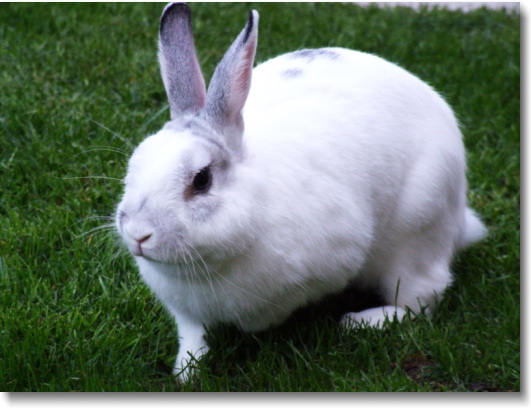Pet Rabbits
Common stereotypes portray the rabbit as a huggable little furry woodland creature. Due to their prey status in nature, most rabbits do not like to be held, and while they are a social animal, they're easily frightened by the overt and affectionate manner of humans. By natural temperament, rabbits are not very well-suited to being the pet of a large predator. However, since their opinion in the matter was not consulted, rabbits have settled into their role as an extremely popular house pet. They are easy to care for, small in size, and cute and fuzzy in appearance. [138] The most important rule to remember in order to get along with your rabbit is that you must get down on the floor. Rabbits are most comfortable when they are approached on their own level, and that level is the floor. At first the rabbit may avoid you, but as he gets used to your presence, he will show confidence in you by being willing to act like a rabbit in your presence. And although naturally wary, rabbits are also curious, and eventually will come over to investigate you. As Amy Espie writes in her article, Honorary Rabbit, ÒItÕs easy to miss gestures of trust from a shy or aloof rabbit. Even friendly, confident bunnies are usually more subtle than cats." Patience and consistency (and an occasional slice of apple or banana) will be your best tools in forming a lasting bond between you and your rabbit. [139] Another thing to remember is that one of the ways rabbits communicate is by nipping. This does not necessarily mean they're trying to be aggressive. Other common rabbit behaviors, particularly for youngsters, are games in which they practice the skills they will need as adults. Kittens primarily play such games such as Chase It, Catch It, and Kill It. Rabbits, having a prey status, play games such as Elude the Capture, as well as Court the Potential Mate, and a variety of King or Queen of the Warren games. A rabbit that zooms up to you, and nudges or nips you, and then races off maybe inviting you to play a game of Catch Me if You Can. [140]
Image Source: Carl Palmer / License under Creative Commons Attribution-Share Alike 2.0 Generic
Available in two sizes:
1024 x 768 || 800 x 600
Many "nuisance" behaviors are actually perfectly natural in the wild, so be patient and ask yourself if this is something the rabbit would have done in the wild. [141] When handling rabbits, there are several things to remember. First, never pick up the rabbit by the ears. [142] A rabbit should always be held by the scruff of the neck, with the bodyweight supported. If the rabbit is allowed to twist and kick out with its powerful hind legs, a serious back injury could occur. [143] Secondly, never turn your rabbit on its back. As with chickens, rabbits can enter a state of "tonic immobility." This trance-like state paralyzes the rabbit's ability to move, although it remains conscious. Tonic immobility is observed in other animals, as well, such as some sharks, lizards, and birds. [144] This technique can be usefully employed by your vet, but as it is stressful for the rabbit it should be used for the minimum time possible. And under no circumstances, should any painful procedures be carried out using this technique as restraint. [145] A common mistake that humans make, when greeting a rabbit, is to present their hand to the rabbit for the rabbit to smell, as you might do with a dog. However, Rabbits cannot see under their nose. This area is in their blind spot, and as a result, this gesture is both confusing and threatening. If you wish to pet a rabbit, keep your hand in view (anywhere but under their nose) and move calmly and firmly. [146]
Vital Statistics
Oryctolagus cuniculus, also known as the European common rabbit, is native to southern Europe and Africa, but feral varieties can be found throughout the world. [147]Phylum Chordata
Subphylum Vertebrata
Class Mammaliaa
Order Lagomorpha
Family Leporidae
[148] [149]
Weight: 2-3 lb (0.9-1.4 kg)
Length: About 16 in. (41 cm) long. [150]
Tail Length: 1.6-2.75 in. ( 40-70 mm). [151]
Fur Color: Grayish brown above and white below. [152]
Habitat: Sandy regions with shrubs and or woody plants, at altitudes of no more than 1,969 ft. (600 m) level. [153]
Copyright © 2008 Rabbit Pictures & Facts
Member of Fohn.net
Image Source for Eastern cottontail at top of page: William R. James, U.S. Fish and Wildlife Service.
Image Source for cottontail at bottom of page: Clinton & Charles Robertson / License under Creative Commons 2.0.
